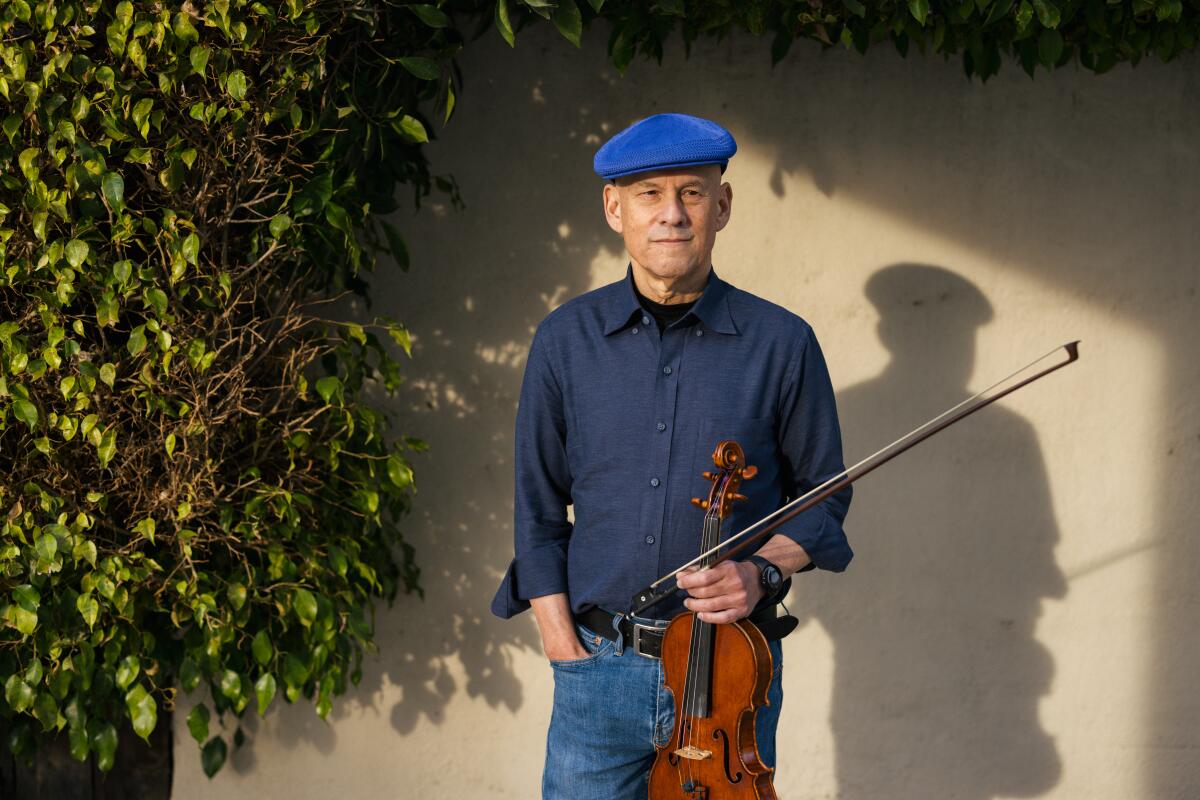Meet the veteran L.A. violinist fighting on behalf of Hollywood musicians

For Marc Sazer, fighting on behalf of Hollywood musicians is a no-brainer. Think of one of your favorite movies, the veteran violinist and labor activist says.
Now imagine it without music.
Sazer has spent four decades bringing music to the screen, playing film and TV scores composed by the likes of Randy Newman and John Williams on Hollywood soundstages.
The son of a professional cellist, Sazer has recorded scores for Steven Spielberg’s cartoon series “Animaniacs,” Fox’s musical smash “Empire,” the Disney-Pixar classic “Finding Nemo” and “Star Wars: The Force Awakens.” He’s performed on tracks for Frank Sinatra and Shirley Horn. He played for Leonard Bernstein as a charter musician for the Mexico City Philharmonic. And until his recent retirement, he served as a tenured first violinist for the Pasadena Symphony.
“I think I had the idea that I would follow in my father’s footsteps and have a string quartet and play in some orchestras and do just enough recording work to support that,” he said, reflecting on his career. “I was very lucky.”
Musicians get improved conditions from Hollywood studios for work in streaming
Sazer, who lives in the Mid-Wilshire area, has now transitioned into another life chapter as a union leader fighting for his fellow Hollywood musicians — the instrumentalists who perform film and TV scores and occasionally appear onscreen in orchestral scenes.
As vice president of the American Federation of Musicians Local 47 for the last two years, the seasoned violinist’s background in film, TV and labor activism is expected to prove instrumental in contract negotiations between the AFM and the Alliance of Motion Picture and Television producers, which commenced Jan. 22.
Sazer and the rest of the AFM bargaining team are lobbying on behalf of some 3,000 guild members for increased wages, improved working conditions, streaming residuals and protections against artificial intelligence under its film and television motion picture contract. Founded in 1896, the AFM boasts more than 70,000 members in total.
Asked if he had always envisioned climbing the labor ladder and becoming a union leader, the soft-spoken Sazer replied, “Not in a million years.”
“I prided myself on being a rank-and-file activist and being the person who was in the workplace all the time and ... not being a suit,” he said. “But at a certain point, it seemed like this was the best pathway to be able to help achieve some of the goals that were really important.”

The musicians’ negotiations come after a year of labor upheaval in the film and TV industry defined by six months of strikes by the Writers Guild of America and the Screen Actors Guild-American Federation of Television and Radio Artists. Many of the issues that mattered most to writers and actors — such as the encroachment of AI and the unintended consequences of streaming — have parallels in the music realm.
But there are also specific items that musicians need addressed, and that’s why having seasoned experts like Sazer — who carry their personal experiences with them to the bargaining table — make all the difference, according to colleagues.
In addition to being an accomplished violinist, Sazer is “well-informed” about the issues affecting musicians and “articulate” when communicating those concerns during bargaining, said Tino Gagliardi, president and chief negotiator of the AFM.
“He’s at the top of his game,” Gagliardi added, “especially when it comes to this contract.”
One of the guild’s biggest concerns is the film and TV industry’s transition to streaming, which has significantly altered the way musicians are compensated for their work.
Sazer described the move to streaming for Hollywood musicians as a “slow-moving train wreck.”
“It’s just devastating,” he said. “More and more of our work is new media — instead of theatrical motion pictures or TV/film — and people can’t make a living at it.”
Among the highest priorities for the AFM is to set up a residual payment system for musicians who record scores for streaming projects. Currently, musicians don’t receive any residuals for streaming content on top of what they are paid for the initial recording session — which is already significantly less, on average, than what they are compensated for working on network TV and theatrical film releases, according to Sazer.
Hollywood’s twin strikes translated into a lost year of production for much of the industry with productions idle since last spring. SAG-AFTRA’s strike against major media companies stretched 118 days.
The guild is also concerned about companies potentially using AI to replace or recycle the work of musicians . Though composers and orchestrators have already begun to use certain AI tools to enhance their work, Sazer said, the union is concerned that employers might compile sounds from previous recording sessions to Frankenstein new scores for completely different projects without hiring human musicians.
Similar to background actors, there’s the looming threat of AI potentially being used to scan musicians’ likenesses and replicate them onscreen for musical scenes.
“When you remove the human aspect of a performance, what does that say about society?” Gagliardi said. “We’ve got to figure out a way to complement the art form rather than replace it.”
“The AMPTP looks forward to productive negotiations with the Federation, with the goal of concluding an agreement that will ensure an active year ahead for the industry and recognize the value that musicians add to motion pictures and television,” the AMPTP said in a statement to The Times.
Born in Compton and raised in Silver Lake, Sazer grew up in a musical family. Like his father, his eldest sister played the cello; his other older sister played the flute; he and his younger sister played the violin; and his mother was a social worker who loved to sing.
He recalled benefiting from a “world of musical privilege” where he had all kinds of access to lessons and instruments. When they tired of rehearsing, Sazer and his sisters would cut “little deals” behind their parents’ backs — secretly shaving five minutes off their practice time and doing their siblings’ chores in exchange for their silence.
“It never occurred to me that [becoming a professional musician] wasn’t a possibility,” Sazer said. “There was always a sense that if I wanted to be a violinist, that was available to me. And it just sort of flowed.”
As streaming takes over the entertainment production world, musicians are being left behind.
Sazer’s family also has a long history of labor activism. His father is a lifelong member of the AFM who went on strike in the early 1980s in pursuit of higher wages and TV residuals.
While studying violin under David Abel at Stanford University, Sazer participated in his first strike as a newly minted member of Local 2007 — the higher education workers branch of the Service Employees International Union.
Between the many hours he spent studying, rehearsing and performing as a music student, Sazer had managed to rack up enough time working as a stage equipment “schlepper” at Dinkelspiel Auditorium to qualify for guild membership.
Two school transfers later, Sazer officially joined the AFM thanks to a couple of gigs he picked up while continuing his studies at Peabody Conservatory under award-winning violinist Charles Libove.
Not long after college, Sazer started getting called for “little TV things,” which gradually became a larger part of his career.
“We’re completely freelance, so any day that you go to work could be the last day of your career. So the level of excellence that’s required just to survive is pretty phenomenal. And people don’t make mistakes. ... The level of excellence here in Los Angeles is stunning.”
Sazer’s involvement with the union started on a technical level, building websites for Local 47 and the Recording Musicians Assn. — a caucus within the guild that represents AFM members who work in film, TV and commercials — in the 1990s. Soon he became more directly engaged with content and policy as a rank-and-file activist.
He dove into union organizing as a member of the AFM’s orchestra committees, researching the issues affecting musicians, appealing to legislators in Sacramento about film and TV tax credits, and participating in multiple guild negotiations and campaigns.
Sazer was elected vice president of Local 47 in February 2022. His predecessor, trumpet player Rick Baptist, resigned in November 2021 due to health concerns.
“[Sazer’s] day doesn’t stop at five o’clock ever,” said violinist and AFM member Joel Pargman. “He’s always there and always responsive and always willing to engage on behalf of musicians. And he’s really one of the most knowledgeable people I know when it comes to the very detailed terms of all of our contracts.”
As streaming takes over the entertainment production world, musicians are being left behind.
Over the past year, Sazer has been busy rallying the rank-and-file, as well as analyzing guild activities, industry practices and trends.
He’s also been connecting with other Hollywood organizations — including the WGA, SAG-AFTRA and crew members guilds IATSE and Teamsters Local 399 — in an effort to strengthen cross-union solidarity.
Sazer was among a number of AFM members who joined the WGA and SAG-AFTRA on the picket lines during their respective strikes last year. Some played their instruments during the demonstrations to boost morale.
Shortly before the actors’ strike wrapped, the AFM, SAG-AFTRA and the American Guild of Musical Artists (the union representing opera singers) assembled for what Sazer called a “fantastic little opera pop-up” featuring vocalists from the Los Angeles Opera, assorted instrumentalists and live piano outside Paramount Pictures.
“This past year has seen a level of solidarity and pulling together and absolutely historic relationship between the unions in the industry,” Sazer said. “That was not because of me, but I do feel good about having played a role in in helping further that.”
More to Read
Inside the business of entertainment
The Wide Shot brings you news, analysis and insights on everything from streaming wars to production — and what it all means for the future.
You may occasionally receive promotional content from the Los Angeles Times.








